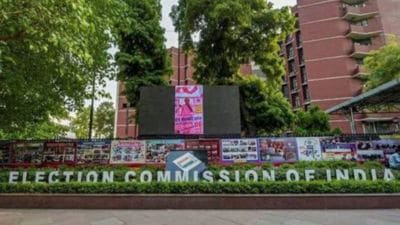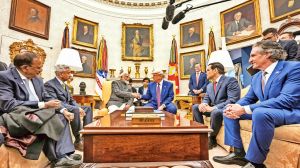As Pippa celebrates Battle of Garibpur, a look back at the forgotten Battle of Kushtia
In every war, there are battles which get highlighted and there are ones that go under the radar. While Garibpur is well-known as far as tanks go, one lesser-known one was the tank ambush at Kushtia in Bangladesh on December 9, 1971.
 ‘The Burning Chaffees’ is a reference to the M-24 Chaffee tanks of the Pakistan Army which came out to be inferior to the PT-76 amphibious tanks of the Indian Army which are referred to in the movie as ‘Pippa’, or a tin can. (Express Archive)
‘The Burning Chaffees’ is a reference to the M-24 Chaffee tanks of the Pakistan Army which came out to be inferior to the PT-76 amphibious tanks of the Indian Army which are referred to in the movie as ‘Pippa’, or a tin can. (Express Archive) The soon-to-be-released movie, Pippa, based on the book “The Burning Chaffees”, which gives the account of the Battle of Garibpur in Bangladesh theatre of 1971 war, has brought into focus the role of tanks in this war and to what extent they were effective in the battle.
The book was written by Brig Balram Singh Mehta (retd) who took part in the Battle of Garibpur as a young officer in the 45 Cavalry. ‘The Burning Chaffees’ is a reference to the M-24 Chaffee tanks of the Pakistan Army which came out to be inferior to the PT-76 amphibious tanks of the Indian Army which are referred to in the movie as ‘Pippa’, or a tin can.
Only three armoured regiments, as tank regiments are called in the Army, were deployed in Bangladesh operations along with two independent armoured squadrons. The bulk of the armour had been deployed in the western theatre of war in Jammu, Punjab, Rajasthan theatres as the Pakistan Army too had deployed its tanks in large numbers there.
Battle of Garibpur
The Battle of Garibpur was fought on November 21 much before the actual war broke out between India and Pakistan. Here, the Indian 14 Punjab Group, which consisted of a squadron of tanks from 45 Cavalry, took on two infantry battalions of Pakistan Army along with an Independent squadron of M-24 Chaffee tanks. The 14 Punjab group also had one platoon 102 Engineer Regiment and 87 Battery, 6 Field Regiment along with elements of 78 Medium Regiment as artillery support.
In this battle, Major DS Narag, who was the Squadron Commander of the 45 Cavalry squadron, took on the Pakistani tanks head-on and ensured the destruction of two enemy tanks before he was hit while he was standing in the tank cupola. His squadron second in command, Capt Balram Mehta took over from him and ensured the destruction of the tanks of Pakistan Army. Major Narag got a well-deserved Mahavir Chakra posthumously.
Battle of Kushtia
In every war, there are battles which get highlighted and there are ones that go under the radar. While Garibpur is well-known as far as tanks go, one lesser-known one was the tank ambush at Kushtia in Bangladesh on December 9, 1971. This is where a group of Indian tankmen of 45 Cavalry and infantry of Rajput Regiment were ambushed by a mix of Pakistani tanks and infantry, and yet these few brave hearts fought back with grit and determination.
Kushtia is also a poignant story about two young Second Lieutenants of Indian and Pakistan armies, with barely a few months service under their belt, who fought and died in the ambush — Second Lieutenant SR Chandavarkar of 45 Cavalry of the Indian Army and Second Lieutenant Abdul Mohsin Khalid Kark of 29 Cavalry of Pakistan Army. While Khalid Kark died after his tank was shot by the tanks of 45 Cavalry, Sam Chandavarkar was captured, tortured and killed by the Pakistani infantry.
Perhaps because of the initial reverses faced by the Indian brigade Kushtia, this action has gradually been forgotten. And so has the bravery of the soldiers of 1 and 3 Troops of ‘A’ Squadron of 45 Cavalry, who gave a good account of themselves despite having found themselves in a sticky situation due to haste by senior commanders, been forgotten.
The tank ambush and the fightback
At around 2 pm on Dec 9, 2/Lt Sam Chandavarkar led the advance into Kushtia as ordered with five tanks. These five tanks were commanded each by Lance Dafadar Shankaran, Naib Risaldar George Thomas, Dafadar Vasu Mallapuram, 2/Lt SR Chandravarkar and Dafadar Cherian Abraham (in this order in the advance).
As soon as the leading tank crossed a culvert on the canal, the tank Commander of the leading tank radioed to 2/Lt Chandavarkar that the area was very still and highly suspect. “The officer decided to move up his tank to the front and lead the column through the built-up area. The tank column thus resumed advance with infantry following, interspersed in its wake. As soon as the last tank crossed over the culvert, an ambush was sprung. The enemy opened up with all weapons, tanks, artillery, infantry automatic and semi-automatic weapons,” the history notes.
The leading tank of Sam Chandavarkar and the third tank got hit and went up in flames. The second tank in line of advance went down the left side of the embankment while engaging the Pakistanis with its main gun and machine gun in a bid to break the ambush. This tank, commanded by Lance Dafadar Shankaran, shot and destroyed a Pakistani M-24 Chafee tank. He kept engaging the enemy till his tank took an artillery hit on its engine deck and was immobilised. The crew then abandoned the tank and retreated on foot.
The engine of the fourth tank in line of advance stalled when trying to engage the reverse gear and could not restart. It thus became a sitting duck on the road embankment and took a number of direct hits from Pakistani tanks, says Colonel Chandra.
It is here that the last tank in the line of advance, led by Dafadar Cherian Abraham, played a pivotal role in saving the lives of the infantry soldiers and took on the Pakistani infantry and tanks with his weapons. He made a quick skid turn, reversed the gun and broke the ambush, while continuously firing. Having crossed over the culvert, the tank got into a hull-down position and destroyed one enemy tank besides giving covering fire to the withdrawing 22 Rajput troops, thus saving the lives of a large number of them.
By 5 pm the situation had stabilised and IAF strikes were called in and more troops were inducted. The rest of the 45 Cavalry ‘A’ Squadron under command of Maj (later Maj Gen) Pramod Batra was also inducted into Kushtia on priority. The town was abandoned by the fleeing Pak troops soon after. Military historians have termed the massive build-up before the town as an overreaction by Indian commanders as very soon almost the entire 4 Mountain Division had assembled there.
Limited armour in Bangladesh theatre
In the Eastern theatre of the 1971 war, there were only three Armoured Regiments- 45 Cavalry, 69 Armoured Regiment and 63 Cavalry. The 45 Cavalry and 69 Armoured Regiment were equipped with PT-76 tanks while 63 Cavalry had T-55 Soviet origin tanks. In addition, there were two independent Armoured Squadrons equipped with the PT -76’s discarded by 63 Cavalry.
The 45 Cavalry fought 29 actions with 17 battalions of the 4 Mountain Division and 9 Infantry Division in Bangladesh. The riverine terrain of Bangladesh was not conducive for armoured operations but even where the tanks could be utilised en masse they were not used so. Instead, they were often dispersed in sub-units and attached to various infantry battalions which reduced their efficiency and effectiveness in many aspects.
The 5 (Independent) Armoured Squadron of 63 Cavalry commanded by Major SS Mehta was involved in three major operations- Akhaura, Ashuganj, and the crossing of the River Meghna. Incidentally, the independent armoured squadron was the only armoured element to be present in Dacca for the Pakistan Army’s surrender ceremony on December 16, 1971, at the end of the war.
According to Capt D P Ramachandran, a military historian, 63 Cavalry, which had fielded five squadrons in all, with an ad hoc squadron and the independent squadron, along with its three regular sabre squadrons, operating in all four sectors, went on to earn the epithet ‘The Ghost Regiment’ from Pakistan Army, for its simultaneous presence on all fronts.












